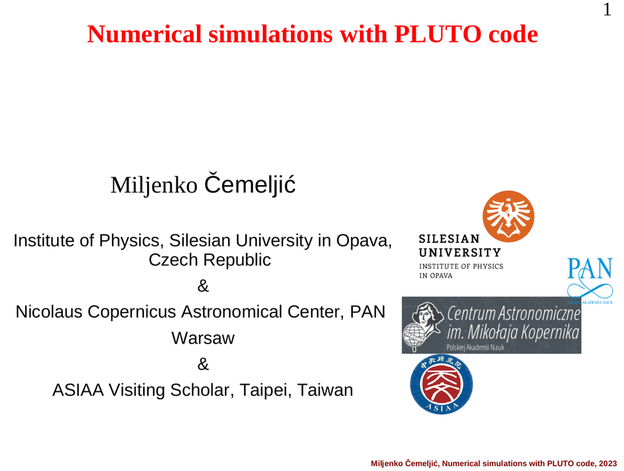Abstract: Aim of the lectures is to guide attendants to active using of the
PLUTO code.
We will work in 5x2 hrs blocks: each hour of theoretical
exposition will be followed by an hour of hands-on work with the code.
We will start with a brief introduction to numerical simulations in
astrophysics and the position of the PLUTO code with respect to
other codes. After a short description of numerical methods employed in the
code, we will proceed with the code installation, testing of the
installation and initial visualization of the results with gnuplot.
Next
we will set a purely hydrodynamic accretion disk in 2D, and learn to use
more advanced visualization tools like Paraview and VisIt. I will also show
the use of Python for visualization.
On the example of adding the magnetic
field in the accretion disk simulation, we will next learn the basics of the
magneto-hydrodynamic simulations, both in ideal and non-ideal (viscous and
resistive) approaches.
I will show how to use a Linux cluster queuing systems for
simulations, and how to plot the magnetic field lines. In the last lecture, we will learn
setting of the full 3D magnetic accretion disk and visualization of the
results.
The core of the covered material does not change, but lectures are adjusted to
the audience and there are minor changes in each edition. Slides from one of the previous
lectures can be found here: Lecture series "Numerical simulations with PLUTO
code", May 04-18, 2021, National Central University (NCU), Zhongli, Taiwan (online),
pdf file
Prerequisites: Free download of the latest version of PLUTO (current version is 4.4.2)
is on
PLUTO webpage.
Minimal working knowledge of Linux will be useful, on the level of using the
terminal in a Linux system like Ubuntu, Fedora or any other version.
Login in a Linux system or a laptop
with Linux partition, with access to C compiler and working Python (version
3.5), or equivalent in MS Win/MacOS environment
will be needed to fully participate in hands-on part of the lectures.
Visualization tools like gnuplot and Paraview or VisIt will be
needed for easy visualization and animation of the results-I will show the basics of
the using of those packages.
References: Mignone et al., 2007,
Mignone
et al., 2007
Cemeljic, 2019,
Cemeljic,
2019 ("Atlas" paper with accretion disk setup in Appendix).
Additional materials for use or download with lectures:
After you download and unpack the code from the above page, it will be in the
PLUTO directory.
Sod shock setups are in PLUTO/Test_Problems/HD/Sod
Orszag-Tang setups are in PLUTO/Test_Problems/MHD/Orszag_Tang
Links to Miki's code setups in below links are not working, please ask by email for the
correct path-this is for traceablity reasons, to know who is using them.
Miki's star-disk problem setup templates in 2.5D cases in half of the co-latitudinal plane
[with theta=(0,PI/2)] are in HD
in 2D
and MHD
in 2D
tar files.
Templates in full 3D star-disk cases (or 2D in a complete co-latitudinal plane [with
theta=(0,PI)] if you define 2D in definitions.h) are in
HD in 3D
and MHD in 3D
tar files.
Here is a version of 3D setup with restart from file obtained in earlier simulation:
MHD3d
restarted from HD3d.
If you use the above templates in your work, remember that it took
considerable time--and tax-payers funding--to develop them, so please make a reference
to the PLUTO code, and the "Atlas" paper mentioned above,
where they are explained: Cemeljic, 2019, A&A, 624, A31.
Python template script for plotting (in case of any problems, make sure you
use >= ver. 3.5) the MHD disk results in 2D with dipole mag. field lines
(for other fields, redefine the field in the script!) and with velocity vectors
in the disk and corona separately defined: velocscr.tar
A detailed general overview on Accretion disks is given in Scholarpedia article on Accretion discs.
In addition to single users, Miki's PLUTO lectures were given to groups in the pinned places:

We will work in 5x2 hrs blocks: each hour of theoretical exposition will be followed by an hour of hands-on work with the code.
We will start with a brief introduction to numerical simulations in astrophysics and the position of the PLUTO code with respect to other codes. After a short description of numerical methods employed in the code, we will proceed with the code installation, testing of the installation and initial visualization of the results with gnuplot.
Next we will set a purely hydrodynamic accretion disk in 2D, and learn to use more advanced visualization tools like Paraview and VisIt. I will also show the use of Python for visualization.
On the example of adding the magnetic field in the accretion disk simulation, we will next learn the basics of the magneto-hydrodynamic simulations, both in ideal and non-ideal (viscous and resistive) approaches.
I will show how to use a Linux cluster queuing systems for simulations, and how to plot the magnetic field lines. In the last lecture, we will learn setting of the full 3D magnetic accretion disk and visualization of the results.
Login in a Linux system or a laptop with Linux partition, with access to C compiler and working Python (version 3.5), or equivalent in MS Win/MacOS environment will be needed to fully participate in hands-on part of the lectures.
Sod shock setups are in PLUTO/Test_Problems/HD/Sod
Orszag-Tang setups are in PLUTO/Test_Problems/MHD/Orszag_Tang


